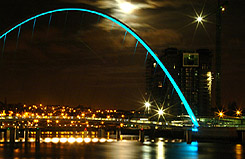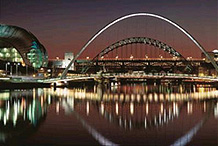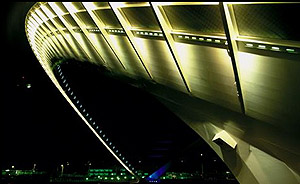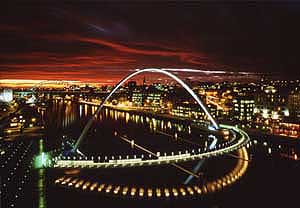Foreword: As an important part of the urban landscape, it can be said that there is a mutual relationship between the bridge and the urban landscape. Its existence is not only to meet the transportation needs of this city, but also to reflect the cultural style and main body of a city. Therefore, a good bridge lighting plan is also very necessary.
Bridge lighting is different from general road lighting. First, as a traffic artery, its lighting must meet road lighting regulations to ensure traffic safety. It is also necessary to consider the aspects of energy conservation and equipment maintenance. The brightness must comply with the relevant regulations as well as anti-glare. Secondly, as part of the urban landscape, its lighting must be ornamental and decorative. The so-called good lighting plan can not distort the original intention of the architect, change the original style, structure and layout of the bridge, and make it glow different from the daytime at night, and portray its outline more vividly and magnificently. Of course, all of these layouts need to be guaranteed not to affect the overall image of the bridge during the day.
It can be seen that bridge lighting is both functional and not negligible. This column will introduce you to the lighting design of the Gateshead Millennium Bridge in the UK, and hope that we can benefit from it.
Related background
In 1996, the Gateshead Council began collecting design proposals for the bridge, which required the designed bridge to contribute to the development of the Tyne River (a river in the northeast of England, with dozens of eastward jets into the North Sea. The economy on both sides of the twin industrial cities of Tyne and Wear, Newcastle and Gateshead, complements the existing six bridges, including the Tyne Bridge, which is based on the famous Sydney Bridge. Where. There are about 150 applications. The final winner was voted by residents of Gateshead (popularity 200,000).
The bridge is made up of two parts: a fixed arch that crosses the Tyne River like a rainbow (somewhat like the famous St. Louis Arch in the United States), and a circular-shaped walking and bicycle that can be rotated upwards by 45 degrees. bridge. This rotating curved pedestrian bridge usually traverses the river horizontally for pedestrians on both sides. Ordinary sized vessels can pass directly under the arc bridge. When a particularly tall ship cannot pass directly, the curved bridge can be lifted up 45 degrees, so that the big ship can pass smoothly. The opening and closing of this bridge is like a beautiful woman who is "blinking" in love with the city lovers on both sides of the river, and thus it has won the nickname of such a "blinking" bridge.

The design concept of the bridge designer is to build a bridge that benefits both pedestrians and vehicles; and the tonnage of the bridge can also make the ship pass smoothly; and the appearance of this new bridge will not affect the world famous here. There are bridges; the most important thing is that you can't block the surrounding piers.
The Gateshead Millennium Bridge received the following lighting design awards:
1. The public recognized the outdoor lighting award, the shortlist for the 2002 year 2. Award from the International Lighting Design Association ( IALD )
3. British National Outdoor Lighting Awards

The lighting design concept used in this bridge is very simple. Its purpose is to make the contours and momentum of the building more magnificent at night. As can be seen from the figure, under the sculpture of the light, the bridge is dotted with stars shining in the night.

In addition, the lighting design of this project is based on low-energy and high-life light sources, and is focused on avoiding light pollution from the light source and its equipment to the sky.

The main arch of the bridge is illuminated by a narrow beam source with color change technology. The main light color is white light, and these light sources are also designed and arranged in advance, thereby creating a very smooth color gradient effect, and the bridge lines are more smooth and beautiful.

The gently flowing Tyne River, illuminated by the wide mirrored river surface, is also illuminated by the underside of the bridge. However, it is worth noting that all the lighting equipment used for the bridge is installed on the upper side of the bridge.

The low-energy, long-life LED light source provides a clear outline of the entire bridge while providing auxiliary illumination for the railings on the bridge. The sidewalk and driveway in the center of the bridge are divided into two areas by the isolation belt. The isolation belt itself is illuminated by the cold-light tube light source from the inside out, and the light passes through the partition layer to illuminate the lane. The sidewalks, driveways and railings are illuminated by a row of white LED light sources that consume only 3 watts per single source.

Finally, in order to create a warning for the intersections and exits of the sidewalks and lanes on the bridge, green and red LED luminaires are used here according to design conventions. The green LED light embedded in the ground indicates “driving†in the form of an arrow, while the red LED light indicates the prohibition of entering. When there are tall ships that need to pass, there will be warning sounds in sync with the lights to remind pedestrians and bicycle arc bridges to be upgraded.

At night, this "blinking" bridge with a very humanized design concept reflects the fascinating effect of modern lighting technology and art under the sculptural lighting and the stars of the sky.

Editor: China Lighting Network / Leaves
Jingkesai Electric Co., Ltd. , http://www.hobaoelec.com